|
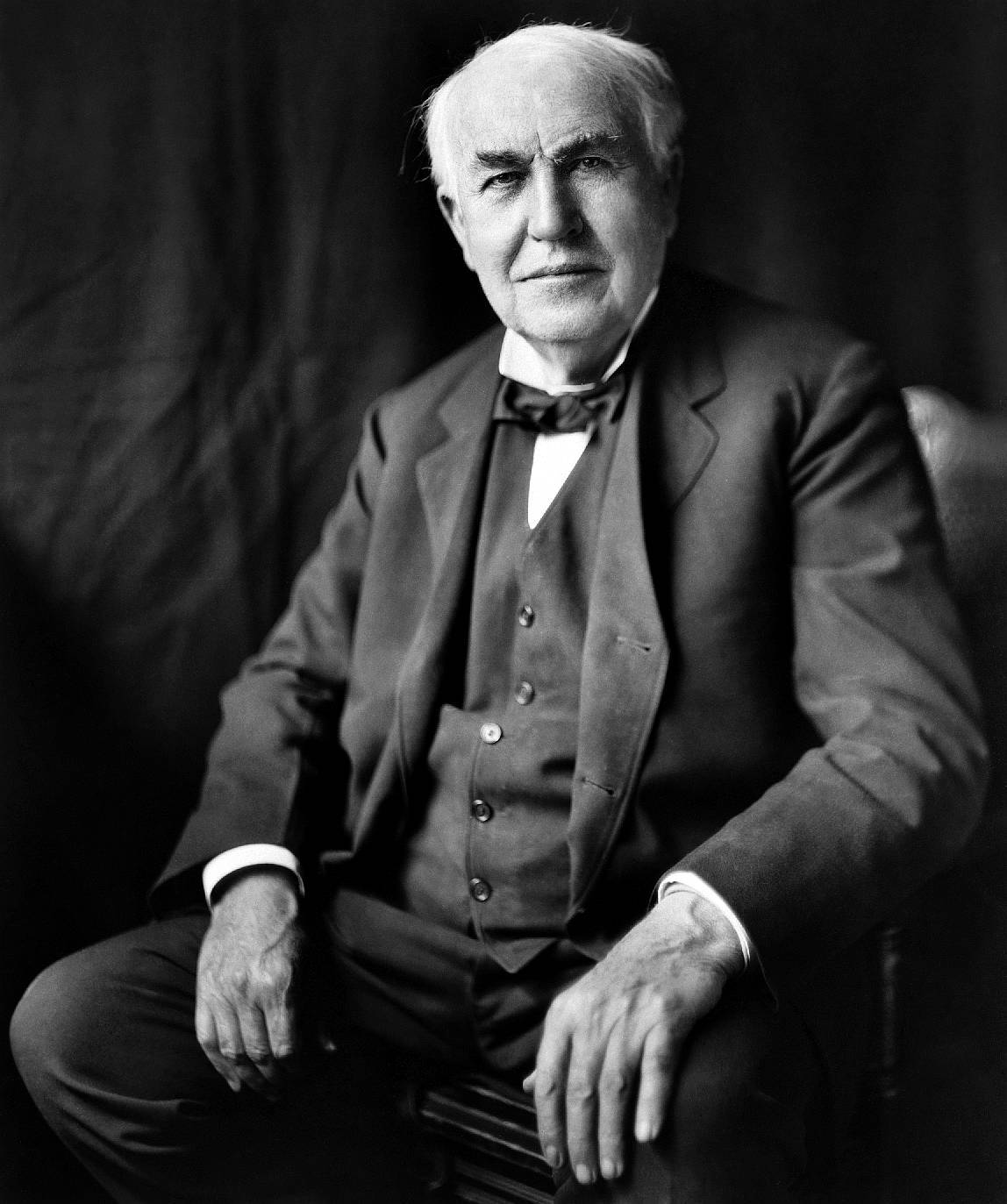
THOMAS
ALVA EDISON - One of the most famous pictures of the prolific
inventor. His thoughts on inventing the electric light bulb: "The electric light has caused me the greatest amount of study and has required the most elaborate experiments.... Although I was never myself discouraged or hopeless of its success, I can not say the same for my associates.... Through all of the years of experimenting with it, I never once made an associated discovery. It was deductive... The results I achieved were the consequence of invention - pure and simple. I would construct and work along various lines until I found them untenable. When one theory was discarded, I developed another at once. I realized very early that this was the only possible way for me to work out all the problems."
From "Edison The Man And His Work" by George S. Bryan 1926.
Thomas Alva Edison (February 11, 1847 – October 18, 1931) was an American inventor and businessman, who has been described as America’s greatest inventor. He developed many devices that greatly influenced life around the world, including the phonograph, the motion picture camera, and the long-lasting, practical electric light bulb. Dubbed "The Wizard of Menlo Park", he was one of the first inventors to apply the principles of mass production and large-scale teamwork to the process of invention, and because of that, he is often credited with the creation of the first industrial research laboratory.
Edison was a prolific inventor, holding 1,093 US patents in his name, as well as many patents in the United Kingdom, France, and Germany. More significant than the number of Edison's patents was the widespread impact of his inventions: electric light and power utilities, sound recording, and motion pictures all established major new industries worldwide. Edison's inventions contributed to mass communication and, in particular, telecommunications. These included a stock ticker, a mechanical vote recorder, a battery for an
electric
car, electrical power, recorded music and motion pictures. His advanced work in these fields was an outgrowth of his early career as a telegraph operator. Edison developed a system of electric-power generation and distribution to homes, businesses, and factories – a crucial development in the modern industrialized world. His first power station was on Pearl Street in Manhattan, New York.
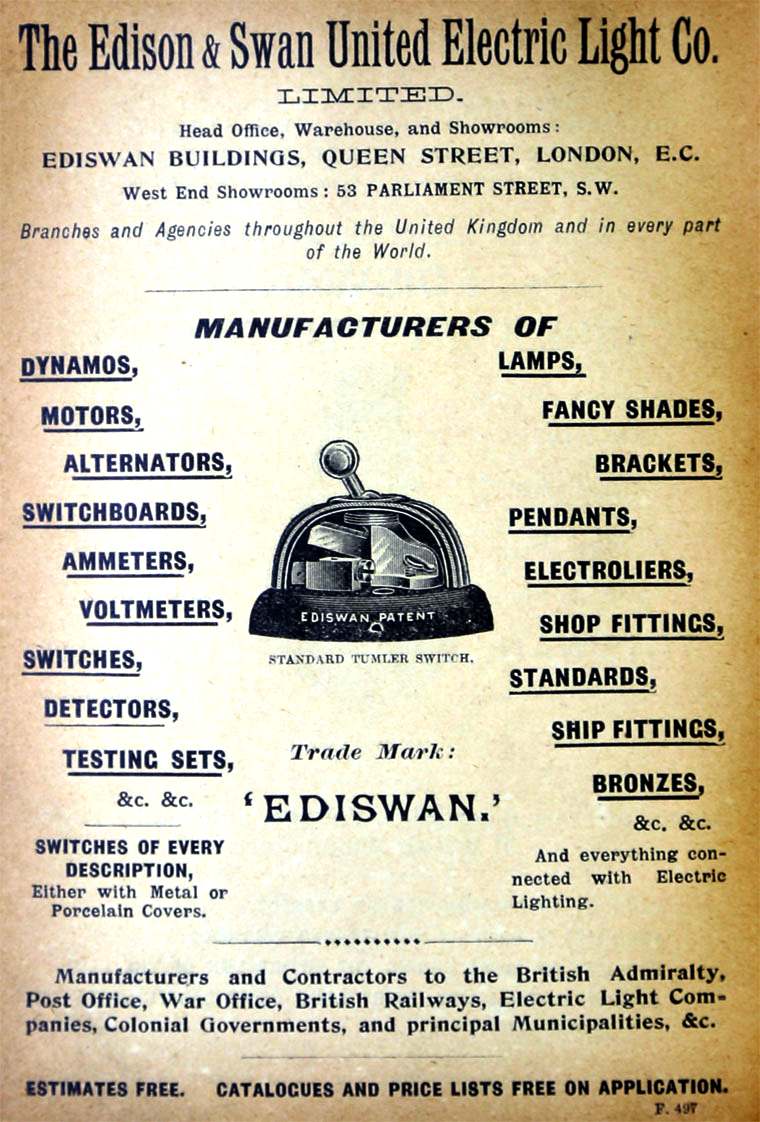
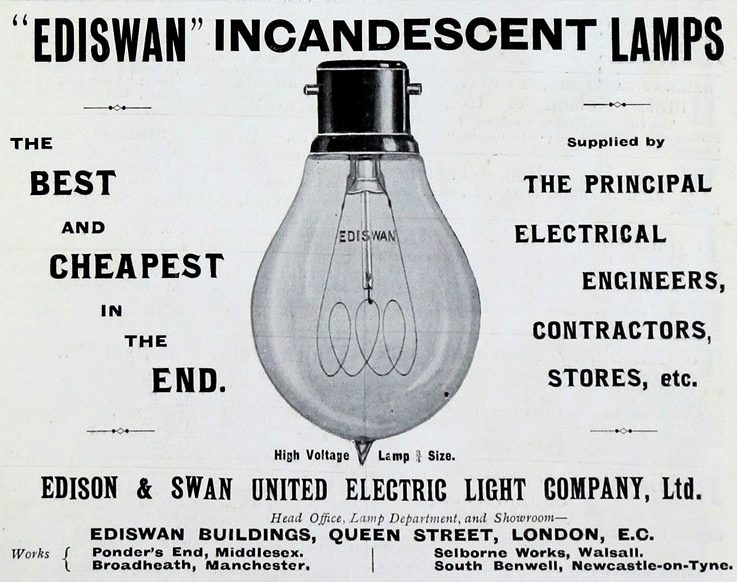
THOMAS
EDISON & JOSEPH SWAN - These were the light switches used at
Herstmonceux Museum. They were dug up by the dozen and some of them will
be on display when the museum opens. A number of light bulbs were found
alongside these switches, but being made of thin glass, none survive
intact.
The
Edison and Swan United Electric Light Co, was based at: 123 to 125 Queen Victoria Street, London, EC.
In 1875 Joseph Swan experimented with incandescent lamps but lacked an adequate vacuum pump. He heard about a newly invented air pump known as a Sprengel pump and applied this to his experiments. Joseph Swan demonstrated the carbon filament light bulb in Newcastle and received a British patent in 1878 for the light bulb.
Thomas Edison turned his attentions to electric lighting towards the end of 1877. He believed that commercially successful lighting needed to have similar characteristics to the existing gas lighting. His early experiments using carbonized paper and carbon were failures. The lamp usually cited as his first success was made on 19th October 1879 but the carbonized cotton used as the conductor was still very fragile. He later found that a particular type of Japanese bamboo was the most satisfactory.
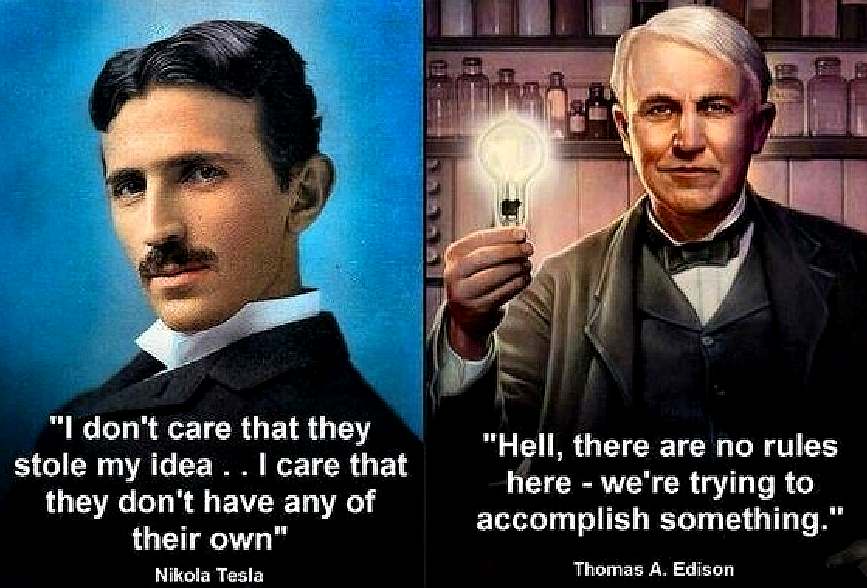
Edison lost in the British courts for infringement of Swan's patent. As part of the settlement, Edison was forced to take Swan in as a partner in his British electric works. The company was called the Edison and Swan United Electric Light Co. Eventually, Edison acquired all of Swan's interest in the company. In 1882 it seemed the obvious choice to merge their British companies and join forces in developing the electric filament light.
1883 In the United States, the U.S. Patent Office had ruled on October 8, 1883 that Edison's patents were based on the prior art of a man named William Sawyer and were invalid. In addition, Swan had already sold his U.S. patent rights to the Brush Electric Company in June of 1882. The Edison and Swan United Electric Light Co Ltd was registered on 26th October, manufacturers of electric lamps and fittings.
1883 The Swan catalogue from 1883 displays the number and types of lamps available. The catalogue lists more than 100 houses and other buildings and 25 ships all lit by Swan's lamps.
We wonder if Lime Park or Lime House is listed therein?
1883 Edison-Swan United Electric Lighting Co established by the amalgamation of the Edison Electric Light Co and the Swan Electric Light Co, and incorporated on 26 October.
Think on that as you admire your LED
lighting that is now all the rage and far more efficient.
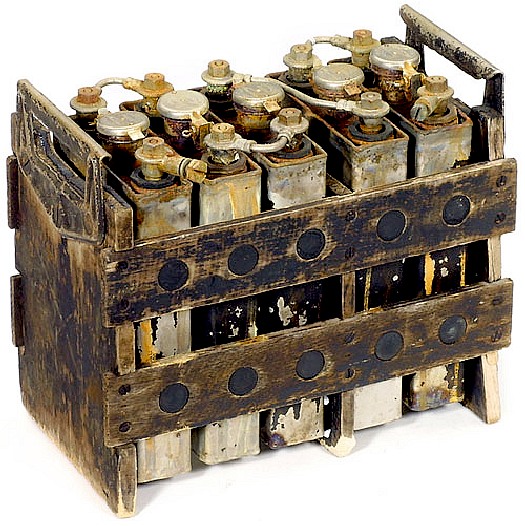
NIFE
1905 - Thomas Edison, who was as much a chemist as an all-around inventor, thought that the lead in Planté-type cells made them too heavy, and that having acid in contact with any metal was an inherently bad idea. After much experimentation, he developed a successful alkaline battery. The Edison cell uses an iron anode, nickel oxide cathode, and KOH electrolyte. This cell is extremely rugged and is still used in certain industrial
applications and locomotives, but it was never able to displace the lead-acid cell as Edison had hoped.
INVENTING
Edison began his career as an inventor in Newark, New Jersey, with the automatic repeater and his other improved telegraphic devices, but the invention that first gained him notice was the phonograph in 1877. This accomplishment was so unexpected by the public at large as to appear almost magical. Edison became known as "The Wizard of Menlo Park," New Jersey.
His first phonograph recorded on tinfoil around a grooved cylinder. Despite its limited sound quality and that the recordings could be played only a few times, the phonograph made Edison a celebrity. Joseph Henry, president of the National Academy of Sciences and one of the most renowned electrical scientists in the US, described Edison as "the most ingenious inventor in this country... or in any other". In April 1878, Edison travelled to Washington to demonstrate the phonograph before the National Academy of Sciences, Congressmen, Senators and US President Hayes. The Washington Post described Edison as a "genius" and his presentation as "a scene... that will live in history". Although Edison obtained a patent for the phonograph in 1878, he did little to develop it until Alexander Graham Bell, Chichester Bell, and Charles Tainter produced a phonograph-like device in the 1880s that used wax-coated cardboard cylinders.
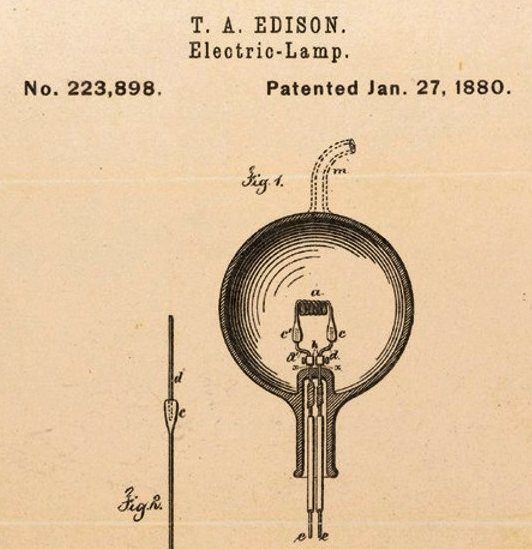
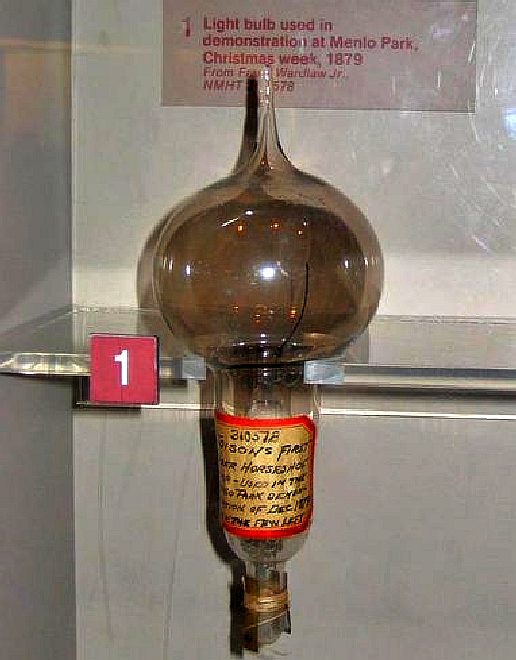
SEE
THE LIGHT - The incentive to generate electricity was driven by the
desire to replace gas lighting with something safer and more convenient.
Gas lighting replaced candles in the evolution of domestic lighting, but
still required the gas to be lit manually. This was a great improvement
on candles, but imagine seeing a light bulb for the first time. No messy
matches and no risk of explosions. It's a bit like comparing
incandescent bulbs to LEDs. Modern lighting using light
emitting diodes is up to 10 times more efficient than some of the
best filament bulbs. Almost all the lighting at Herstmonceux Museum is
now LED, even the external security lamps.
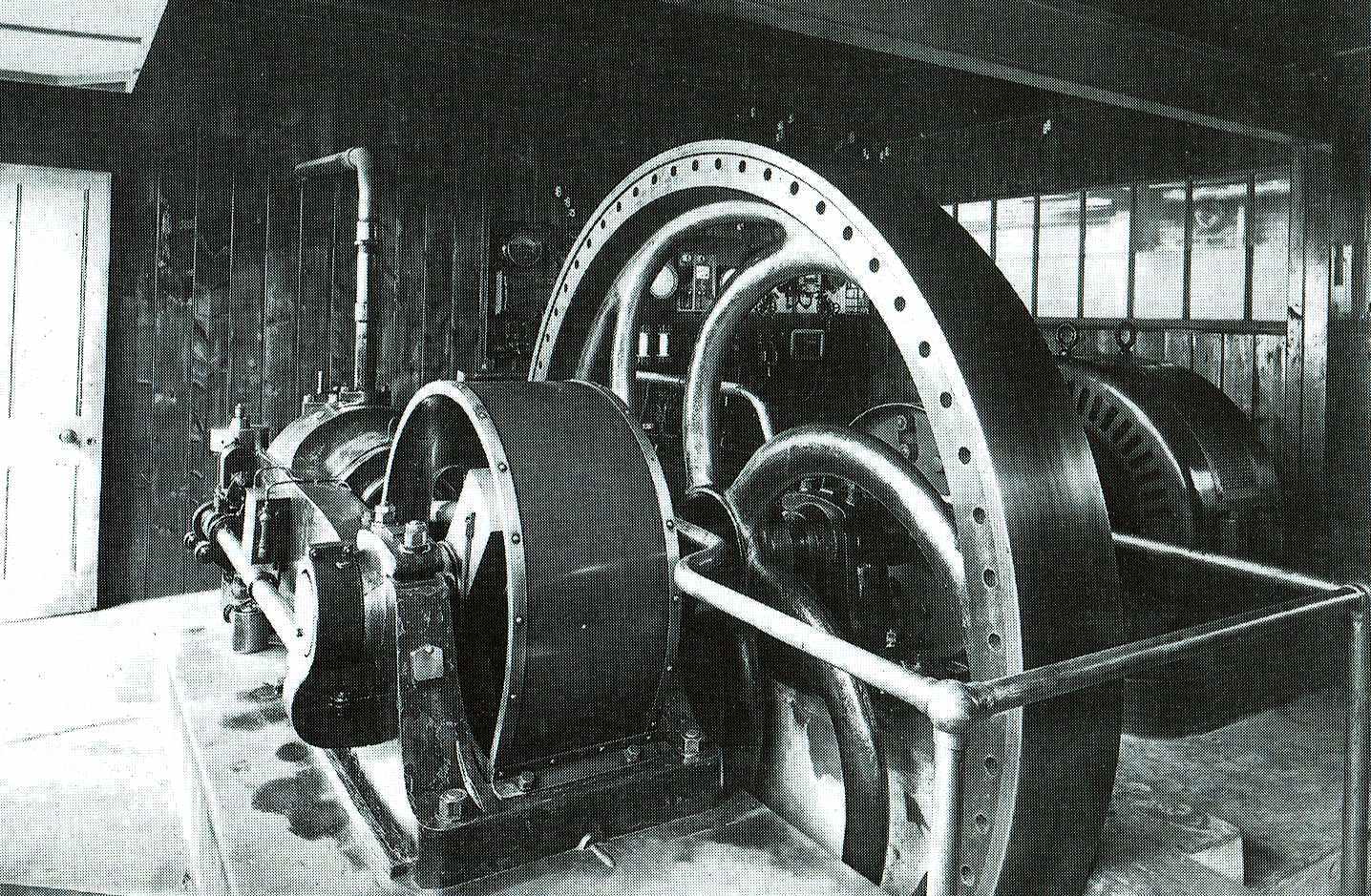
GAS
ENGINE GENERATOR - In 1889, The National Gas & Oil Engine Company, Ltd., was founded by Mr H. N. Bickerton who after being in business for some time as an engineer, ventured into the realms of horizontal gas engine manufacture. For this purpose he
took over a works in Wellington Road formerly occupied by Isaac Watt Boulton to build locomotives. Export trade commenced in 1894, when the first gas engine was delivered to France.
As the years went by, extensions were put in hand at Wellington Rd. Offices were built and new bays erected. These included an Iron Foundry, Drawing Office, Pattern Shop, Shipping Departments etc. By 1908, the demand for small horizontal gas engines was diminishing rapidly, ironically, due to competition from the electric motor and in that year, work was commenced on building a new block of bays at the west end of the works for the manufacture of vertical tandem gas engines up to units of 2,000 b.h.p. with 12 cylinders having a bore and stroke of 26in x 24in. Many installations of 10,000 b.h.p. or more were laid down at collieries, iron and steel works etc., for running on blast furnace and coke oven gases. This new section of the works was equipped with special machines for carrying out this operation.
In 1914, National installed the first sewage gas engine at the Birmingham, Tame and Rea Drainage Board's works, and from that date supplied more sewage engines in the British Empire than any other firm. During the 1914-1918 war the Company undertook the building of Y-type 12 cylinder engines for high-speed naval craft. In addition a great number of engines were supplied to various factories sponsored by the Ministry of Supply.
THE
ELECTRIC LIGHT BULB
In 1878 Edison began working on a system of electrical illumination, something he hoped could compete with gas and oil based lighting. He began by tackling the problem of creating a long-lasting incandescent lamp, something that would be needed for indoor use. Many earlier inventors had previously devised incandescent lamps, including Alessandro Volta's demonstration of a glowing wire in 1800 and inventions by Henry Woodward and Mathew Evans. Others who developed early and commercially impractical incandescent electric lamps included Humphry Davy, James Bowman Lindsay, Moses G. Farmer, William E. Sawyer, Joseph Swan and Heinrich Göbel. Some of these early bulbs had such flaws as an extremely short life, high expense to produce, and high electric current drawn, making them difficult to apply on a large scale commercially. Edison realized that in order to keep the thickness of the copper wire needed to connect a series of electric lights to an economically manageable size he would have to come up with a lamp that would draw a low amount of current. This meant the lamp would have to have a high resistance and run at a relatively low voltage (around 110 volts).
After many experiments, first with carbon filaments and then with platinum and other metals, in the end, Edison returned to a carbon filament. The first successful test was on October 22, 1879; it lasted 13.5 hours. Edison continued to improve this design and by November 4, 1879, filed for U.S. patent 223,898 (granted on January 27, 1880) for an electric lamp using "a carbon filament or strip coiled and connected to platina contact wires". This was the first commercially practical incandescent light.
Although the patent described several ways of creating the carbon filament including "cotton and linen thread, wood splints, papers coiled in various ways", it was not until several months after the patent was granted that Edison and his team discovered a carbonized bamboo filament that could last over 1,200 hours. The idea of using this particular raw material originated from Edison's recalling his examination of a few threads from a bamboo fishing pole while relaxing on the shore of Battle Lake in the present-day state of Wyoming, where he and other members of a scientific team had traveled so that they could clearly observe a total eclipse of the sun on July 29, 1878, from the Continental Divide.
In 1878, Edison formed the Edison Electric Light Company in New York City with several financiers, including J. P. Morgan, Spencer Trask, and the members of the Vanderbilt family. Edison made the first public demonstration of his incandescent light bulb on December 31, 1879, in Menlo Park. It was during this time that he said: "We will make electricity so cheap that only the rich will burn candles."
Henry Villard, president of the Oregon Railroad and Navigation Company, had attended Edison's 1879 demonstration. Villard quickly became impressed and requested Edison install his electric lighting system aboard his company's new steamer, the Columbia. Although hesitant at first, Edison relented and agreed to Villard's request. Following most of its completion in May 1880, the Columbia was sent to New York City, where Edison and his personnel installed Columbia's new lighting system. Due to this, the Columbia became Edison's first commercial application for his incandescent light bulb. The Edison equipment was eventually removed from Columbia in 1895.
Lewis Latimer joined the Edison Electric Light Company in 1884. Latimer had received a patent in January 1881 for the "Process of Manufacturing Carbons", an improved method for the production of carbon filaments for light bulbs. Latimer worked as an engineer, a draftsman and an expert witness in patent litigation on electric lights.
George Westinghouse's company bought Philip Diehl's competing induction lamp patent rights (1882) for $25,000, forcing the holders of the Edison patent to charge a more reasonable rate for the use of the Edison patent rights and lowering the price of the electric lamp.
On October 8, 1883, the US patent office ruled that Edison's patent was based on the work of William E. Sawyer and was, therefore, invalid. Litigation continued for nearly six years, until October 6, 1889, when a judge ruled that Edison's electric light improvement claim for "a filament of carbon of high resistance" was valid. To avoid a possible court battle with Joseph Swan, whose British patent had been awarded a year before Edison's, he and Swan formed a joint company called Ediswan to manufacture and market the invention in
Britain.
Mahen Theatre in Brno (in what is now the Czech Republic), which opened in 1882, was the first public building in the world to use Edison's electric lamps, with the installation supervised by Edison's assistant in the invention of the lamp, Francis Jehl. In September 2010, a sculpture of three giant light bulbs was erected in Brno, in front of the theatre.
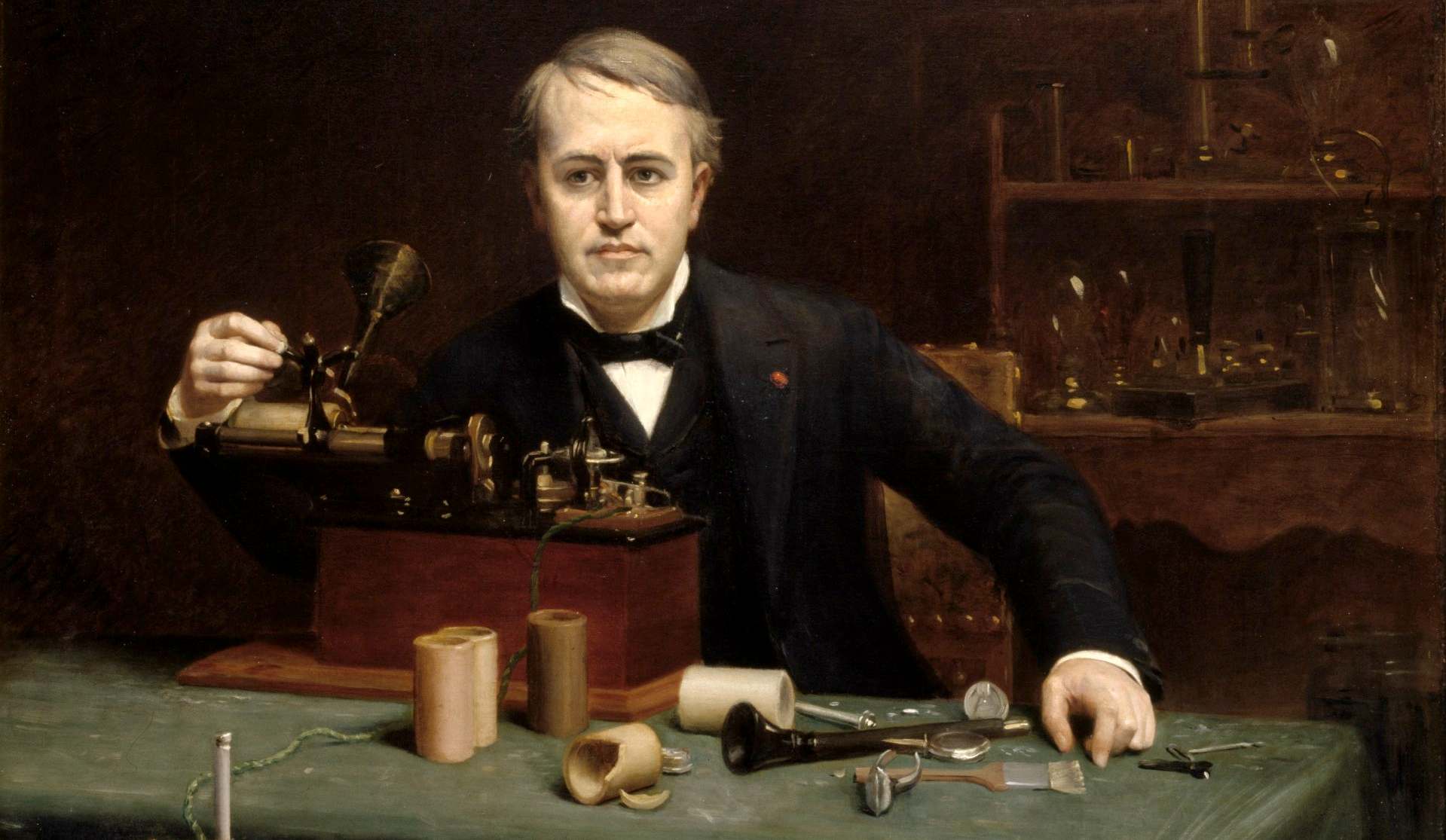
ELECTRICITY POWER DISTRIBUTION
After devising a commercially viable electric light bulb on October 21, 1879, Edison went on to develop an electric "utility" designed to compete with the then existent gas lighting utilities. On December 17, 1880, he founded the Edison Illuminating Company and during the 1880s he patented a system for electricity distribution. The company established the first investor-owned electric utility in 1882 on Pearl Street Station, New York City. It was on September 4, 1882, that Edison switched on his
Pearl Street generating station's electrical power distribution system, which provided 110 volts direct current (DC) to 59 customers in lower Manhattan.
Earlier in the year, in January 1882, he had switched on the first steam-generating power station at Holborn Viaduct in London. The DC supply system provided electricity supplies to street lamps and several private dwellings within a short distance of the station. On January 19, 1883, the first standardized incandescent electric lighting system employing overhead wires began service in Roselle, New Jersey.
DC Vs AC
As Edison was expanding his direct current (DC) power delivery system he began receiving stiff competition from companies installing alternating current (AC) systems. From the early 1880s on AC arc lighting systems for streets and large spaces had been an expanding business in the US. With the development of transformers in Europe and by Westinghouse Electric in the US in 1885-1886 it became possible to transmit AC very long distances over thinner and cheaper wires, and "step down" the voltage at the destination for distribution to users. This allowed AC to be used not only in street lighting but also in lighting for small business and domestic customers, the market Edison's patented low voltage DC incandescent lamp system had been designed to supply.
Edison's DC empire began suffering from one of its chief drawbacks: it was suitable only for the high density of customers found in large cities. Edison's DC plants could not deliver electricity to customers who were more than one mile from the plant and the short range left a patchwork of un-supplied customers in-between plants. Small cities and rural areas could not afford an Edison style system at all. This left a large part of the market without electrical service and AC companies were expanding into this gap.
Edison expressed views that AC was unworkable and the high voltages used were dangerous. As George Westinghouse was installing his first AC systems in 1886, Thomas Edison began a pattern of striking out personally against his chief rival stating, "Just as certain as death, Westinghouse will kill a customer within six months after he puts in a system of any size. He has got a new thing and it will require a great deal of experimenting to get it working practically." Many reasons have been put forward for Edison's anti-AC stance. One notion is that the inventor may not have been able to grasp the more abstract theories behind AC and was trying to avoid developing a system he did not understand. Edison also appeared to have been worried about the high voltage from some competitor's misinstalled AC system killing customers and hurting the sales of electric power systems in general. On top of all that was the simple fact that Edison Electric had based their entire design on low voltage DC and switching a standard after they had installed over 100 systems was, in Edison's mind, out of the question. By the end of 1887, Edison Electric was beginning to lose market share with Westinghouse, who had built 68 AC-based power stations to Edison's 121 DC-based stations. To make matters worse for Edison, the Thomson-Houston Electric Company of Lynn, Massachusetts (another AC-based competitor) had built 22 power stations.
Parallel to the expanding competition between Edison and the AC companies was a rising public furor over a series of deaths in the spring of 1888 caused by pole mounted high voltage alternating current lines that turned into a media frenzy against the current and the seemingly greedy and callous lighting companies that used it. Edison took advantage of the public perception that AC was dangerous and teamed up with the self-styled New York anti-AC crusader Harold P. Brown in a propaganda campaign, aiding Brown in the public electrocution of animals with AC as well as supported legislation to control and severely limit AC installations and voltages (to the point of making it an ineffective power delivery system) in what was now being referred to as a "battle of currents". The development of the electric chair was used in an attempt to portray AC as having a greater lethal potential than DC and smear Westinghouse at the same time via Edison colluding with Brown and Westinghouse's chief AC rival, the Thomson-Houston Electric Company, to make sure the first electric chair was powered by a Westinghouse AC generator.
Thomas Edison's staunch anti-AC tactics were not sitting well with his own stockholders. By the early 1890s, Edison's company was generating much smaller profits than its AC rivals, and the War of Currents would come to an end in 1892 with Edison being forced out of controlling his own company. That year the financier
J P Morgan engineered a merger of Edison General Electric with Thomson-Houston that basically put the board of Thomson-Houston in charge of the new company called General Electric (dropping "Edison" from its name). General Electric now controlled three-quarters of the US electrical business and would go on to compete with Westinghouse for the AC market.
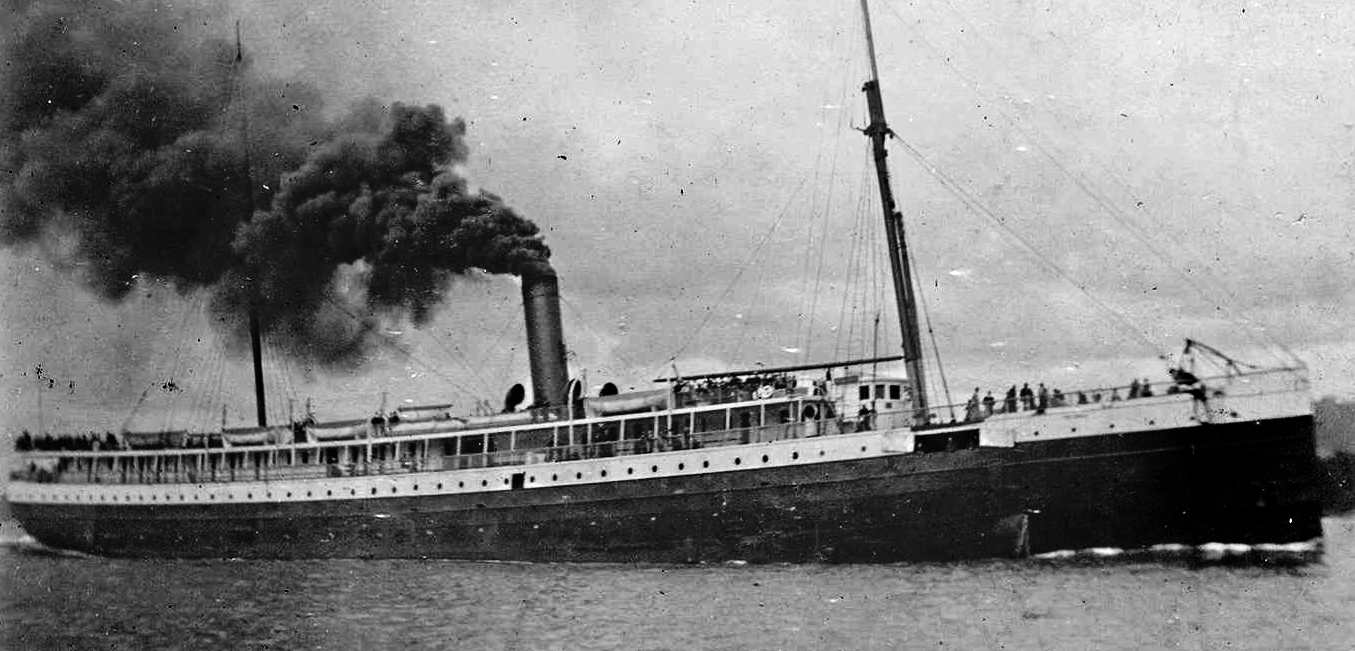
SS
COLUMBIA - This was the first ship to feature electric lighting in
1880. It was owned by the Oregon Railroad and Navigation Company.
MENLO
PARK
Edison's major innovation was the first industrial research lab, which was built in Menlo Park, a part of Raritan Township, Middlesex County, New Jersey (today named Edison in his honor). It was built with the funds from the sale of Edison's quadruplex telegraph. After his demonstration of the telegraph, Edison was not sure that his original plan to sell it for $4,000 to $5,000 was right, so he asked Western Union to make a bid. He was surprised to hear them offer $10,000 ($211,700 in today's
dollars.), which he gratefully accepted. The quadruplex telegraph was Edison's first big financial success, and Menlo Park became the first institution set up with the specific purpose of producing constant technological innovation and improvement. Edison was legally attributed with most of the inventions produced there, though many employees carried out research and development under his direction. His staff was generally told to carry out his directions in conducting research, and he drove them hard to produce results.
William Joseph Hammer, a consulting electrical engineer, started working for Edison and began his duties as a laboratory assistant in December 1879. He assisted in experiments on the telephone, phonograph, electric railway, iron ore separator, electric lighting, and other developing inventions. However, Hammer worked primarily on the incandescent electric lamp and was put in charge of tests and records on that device (see Hammer Historical Collection of Incandescent Electric Lamps). In 1880, he was appointed chief engineer of the Edison Lamp Works. In his first year, the plant under General Manager Francis Robbins Upton turned out 50,000 lamps. According to Edison, Hammer was "a pioneer of incandescent electric lighting". Frank J. Sprague, a competent mathematician and former naval officer, was recruited by Edward H. Johnson and joined the Edison organization in 1883. One of Sprague's contributions to the Edison Laboratory at Menlo Park was to expand Edison's mathematical methods. Despite the common belief that Edison did not use mathematics, analysis of his notebooks reveal that he was an astute user of mathematical analysis conducted by his assistants such as Francis Robbins Upton, for example, determining the critical parameters of his electric lighting system including lamp resistance by an analysis of Ohm's Law, Joule's Law and economics.
Nearly all of Edison's patents were utility patents, which were protected for a 17-year period and included inventions or processes that are electrical, mechanical, or chemical in nature. About a dozen were design patents, which protect an ornamental design for up to a 14-year period. As in most patents, the inventions he described were improvements over prior art. The phonograph patent, in contrast, was unprecedented as describing the first device to record and reproduce sounds.
In just over a decade, Edison's Menlo Park laboratory had expanded to occupy two city blocks. Edison said he wanted the lab to have "a stock of almost every conceivable material". A newspaper article printed in 1887 reveals the seriousness of his claim, stating the lab contained "eight thousand kinds of chemicals, every kind of screw made, every size of needle, every kind of cord or wire, hair of
humans,
horses, hogs,
cows, rabbits, goats, minx,
camels ... silk in every texture, cocoons, various kinds of hoofs,
shark's
teeth, deer horns, tortoise shell ... cork, resin, varnish and oil, ostrich feathers, a peacock's tail, jet, amber, rubber, all ores ..." and the list goes on.
Over his desk, Edison displayed a placard with Sir Joshua Reynolds' famous quotation: "There is no expedient to which a man will not resort to avoid the real labor of thinking." This slogan was reputedly posted at several other locations throughout the facility.
With Menlo Park, Edison had created the first industrial laboratory concerned with creating knowledge and then controlling its application. Edison's name is registered on 1,093 patents.
SOME
OF EDISON'S MOST FAMOUS QUOTES:
*
My main purpose in life is to make enough money to create ever more inventions.... The dove is my emblem.... I want to save and advance human life, not destroy it.... I am proud of the fact that I have never invented weapons to kill....
* I never perfected an invention that I did not think about in terms of the service it might give others... I find out what the world needs, then I proceed to invent....
* My principal business consists of giving commercial value to the brilliant, but misdirected, ideas of others.... Accordingly, I never pick up an item without thinking of how I might improve it.
* I readily absorb ideas from every source, frequently starting where the last person left off.
* Because ideas have to be original only with regard to their adaptation to the problem at hand, I am always extremely interested in how others have used them....
* A good idea is never lost. Even though its originator or possessor may die without publicizing it, it will someday be reborn in the mind of another....
* I am not overly impressed by the great names and reputations of those who might be trying to beat me to an invention.... Its their 'ideas' that appeal to me. I am quite correctly described as 'more of a sponge than an inventor....'
* "Genius is one per cent inspiration and ninety-nine per cent perspiration. Accordingly, a 'genius' is often merely a talented person who has done all of his or her homework."
* Opportunity is missed by most people because it is dressed in overalls and looks like work.
* The first requisite for success is to develop the ability to focus and apply your mental and physical energies to the problem at hand - without growing weary. Because such thinking is often difficult, there seems to be no limit to which some people will go to avoid the effort and labor that is associated with it....
* I never did anything worth doing entirely by accident.... Almost none of my inventions were derived in that manner. They were achieved by having trained myself to be analytical and to endure and tolerate hard work.
* Inspiration can be found in a pile of junk. Sometimes, you can put it together with a good imagination and invent something.
* Personally, I enjoy working about 18 hours a day. Besides the short catnaps I take each day, I average about four to five hours of sleep per night.
* Most of the exercise I get is from standing and walking all day from one laboratory table to another. I derive more benefit and entertainment from this than some of my friends and competitors get from playing games like golf.
* If we all did the things we are really capable of doing, we would literally astound ourselves....
* Our schools are not teaching students to think. It is astonishing how many young people have difficulty in putting their brains definitely and systematically to work....
* The three things that are most essential to achievement are common sense, hard work and stick-to-it-iv-ness.....
* I have far more respect for the person with a single idea who gets there than for the person with a thousand ideas who does nothing....
* Many of life's failures are experienced by people who did not realize how close they were to success when they gave up.
* Pretty much everything will come to him who hustles while he waits. I believe that restlessness is discontent, and discontent is merely the first necessity of progress. Show me a thoroughly satisfied man and I will show you a failure.
* Unfortunately, there seems to be far more opportunity out there than ability.... We should remember that good fortune often happens when opportunity meets with preparation.
* Just because something doesn't do what you planned it to do in the first place doesn't mean it's useless....
* Results? Why, man, I have gotten lots of results! If I find 10,000 ways something won't work, I haven't failed. I am not discouraged, because every wrong attempt discarded is often a step forward....
* Surprises and reverses can serve as an incentive for great accomplishment. There are no rules here, we're just trying to accomplish something.
* As a cure for worrying, work is far better than whiskey. I always found that, if I began to worry, the best thing I could do was focus upon doing something useful and then work very hard at it. Soon, I would forget what was troubling me.
* Barring serious accidents, if you are not preoccupied with worry and you work hard, you can look forward to a reasonably lengthy existence.... Its not the hard work that kills, its the worrying that kills.
* The only time I really become discouraged is when I think of all the things I would like to do and the little time I have in which to do them.
* The thing I lose patience with the most is the clock. Its hands move too fast.
* Time is really the only capital that any human being has and the thing that he can least afford to waste or lose...
* From his neck down a man is worth a couple of dollars a day, from his neck up he is worth anything that his brain can produce.
* The doctor of the future will give no medicine, but will interest his patients in the care of the human body, in diet, and in the cause and prevention of disease.
* Whatever the mind of man creates, should be controlled by man's character.
* I love great music and art, but I think 'cubist' songs and paintings are hideous.
* Someday, man will harness the rise and fall of the tides, imprison the power of the sun, and release atomic power.
* I am both pleased but astonished by the fact that mankind has not yet begun to use all the means and devices that are available for destruction. I hope that such weapons are never manufactured in quantity.
* The United
States, and other advanced nations, will someday be able to produce instruments of death so terrible the world will be in abject terror of itself and its ability to end civilization.... Such war-making weapons should be developed - but only for purposes of discovery and experimentation
* The dove is my emblem.... I want to save and advance human life, not destroy it.... I am proud of the fact that I never invented weapons to kill...
* To me, the idea and expectation that the day is slowly and surely coming when we will be able to honestly say we are our brother's keeper and not his oppressor is very beautiful .
* Until man duplicates a blade of grass, nature can laugh at his so-called scientific knowledge....
* Its obvious that we don't know one millionth of one percent about anything.
* I believe that the science of chemistry alone almost proves the existence of an intelligent creator.
* We have merely scratched the surface of the store of knowledge which will come to us. I believe that we are now, a-tremble on the verge of vast discoveries - discoveries so wondrously important they will upset the present trend of human thought and start it along completely new lines .
* Be courageous! Whatever setbacks America has encountered, it has always emerged as a stronger and more prosperous nation.... Be brave as your fathers before you. Have faith and go forward!
* If parents pass enthusiasm along to their children, they will leave them an estate of incalculable value....
* The memory of my mother will always be a blessing to me....
* Life's most soothing things are a child's goodnight and sweet music....
* Great music and art are earthly wonders, but I think 'cubist' songs and paintings are hideous.
* Even though I am nearly deaf, I seem to be gifted with a kind of inner hearing which enables me to detect sounds and noises that the listeners do not perceive.
* Of all my inventions, I liked the phonograph best...."
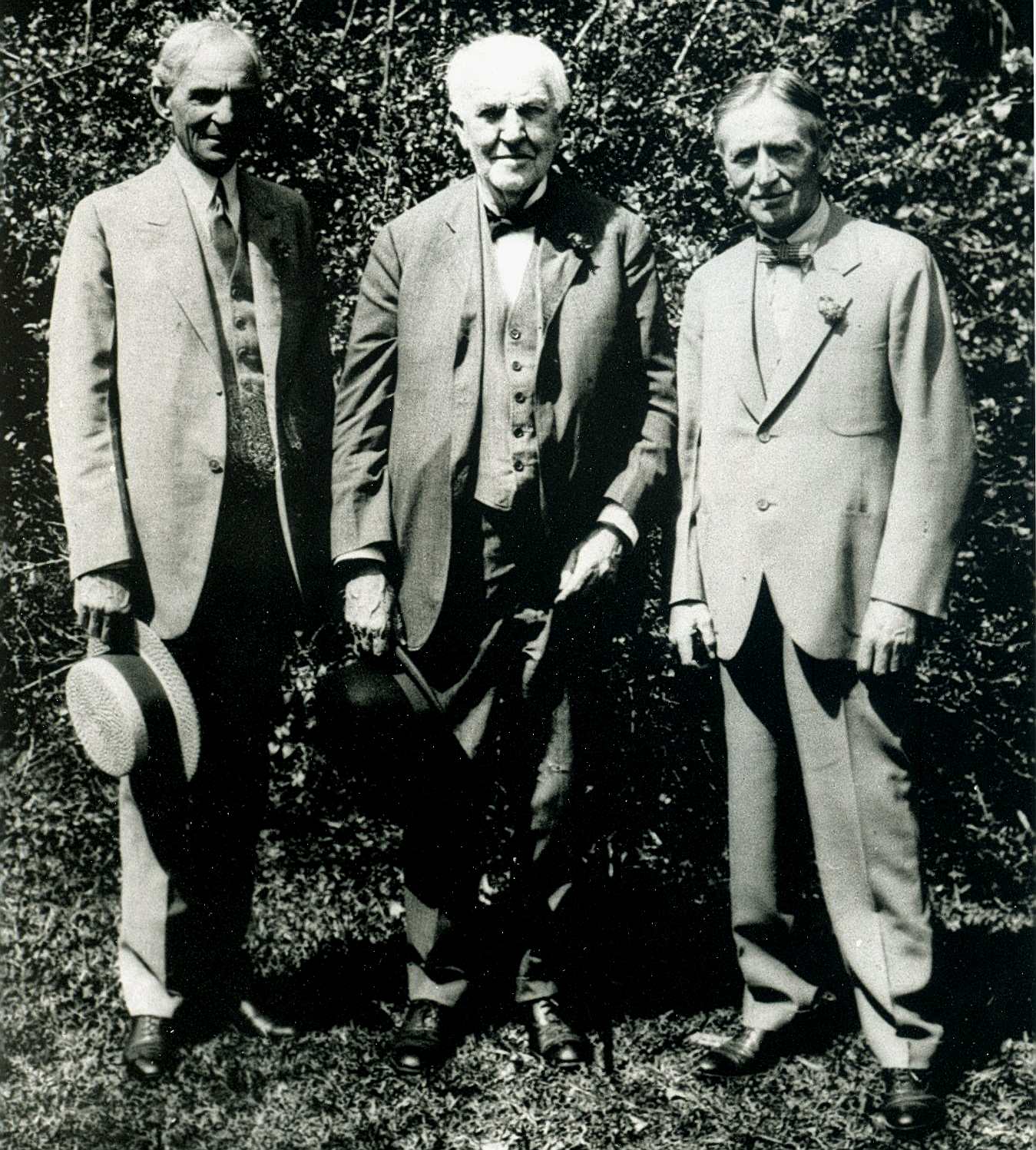
BRAIN
BANK - Henry Ford, Thomas Edison and Harvey Firestone, three men in
US history that changed the face of the world. Henry gave us cheap
motoring. Thomas gave us music, lighting on tap and Harvey gave us grip
when driving, although it was Dunlop who invented the pneumatic tyre.
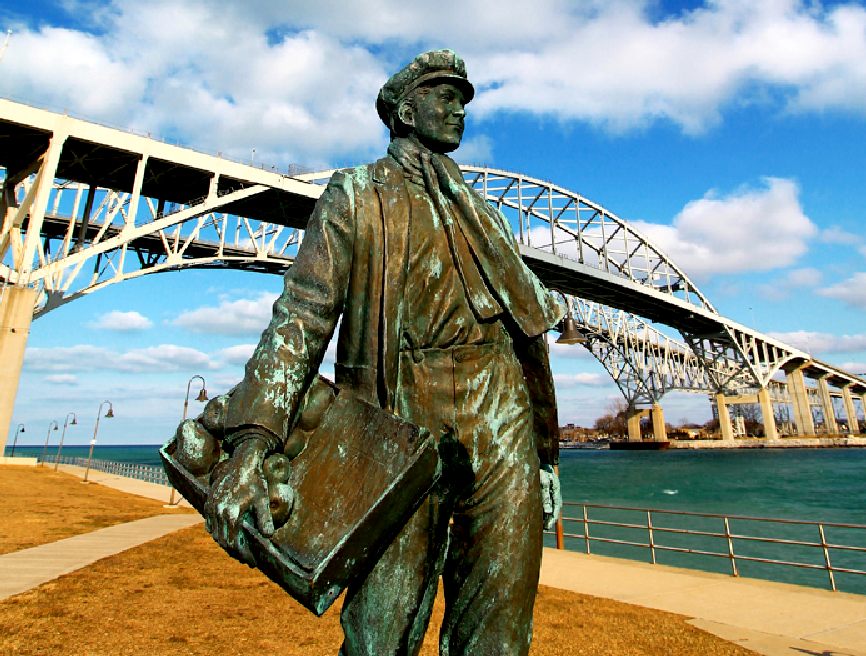
BRONZE -
This the statue of Thomas Edison as a young man, situated by the railway
tracks at Port Huron, Michigan.
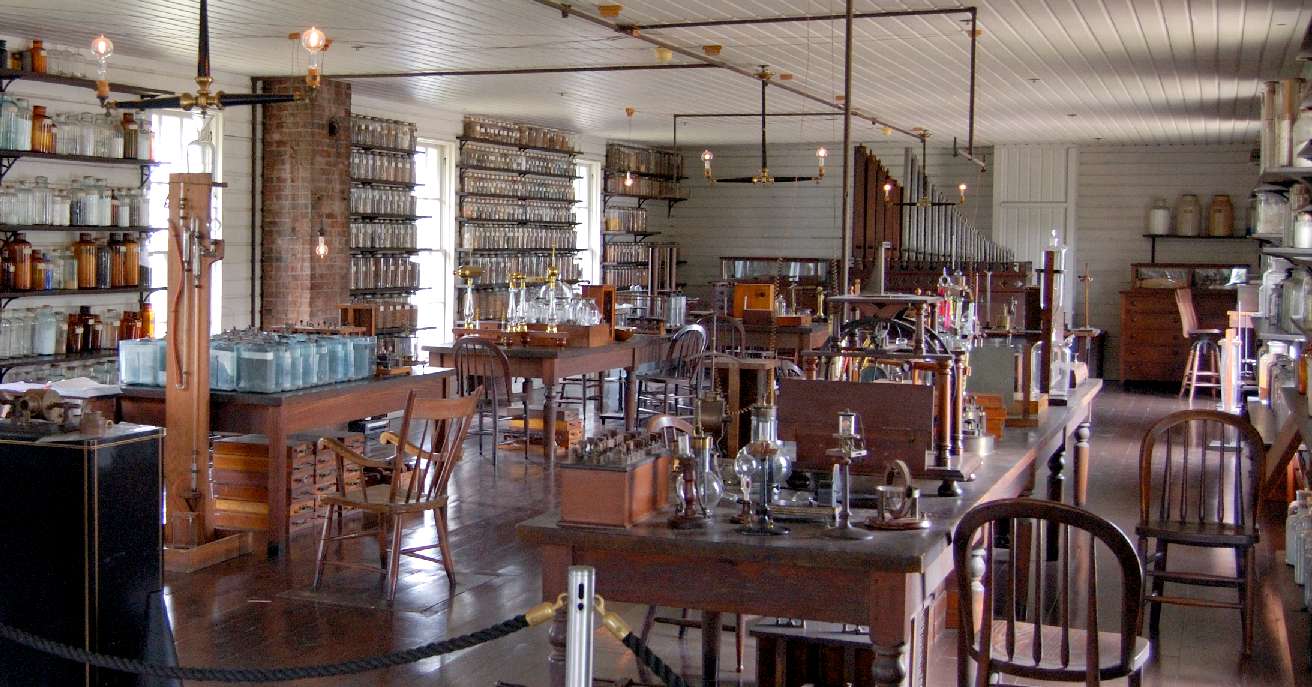
MENLO
PARK - A fantastic laboratory, the envy of all at Herstmonceux
Museum, a working museum that also has a laboratory for robotics, but
nowhere near as grand as this.
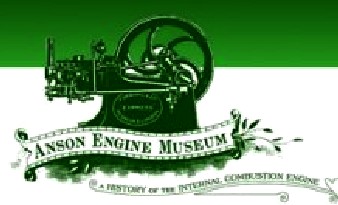
LINKS
& REFERENCE
https://en.wikipedia.org/wiki/Thomas_Edison
https://en.wikipedia.org/wiki/Thomas_Edison
http://www.thomasedison.com/
http://www.thomasedison.com/
Graces
guide UK Charles_Hopkinson_1854 - 1920
Graces
guide UK John_Hopkinson_1849_-_1898
Graces
guide UK Edison_and_Swan_United_Electric_Light_Co
http://www.gracesguide.co.uk/Charles_Hopkinson_(1854-1920)
http://www.gracesguide.co.uk/John_Hopkinson_(1849_-_1898)
http://www.gracesguide.co.uk/Edison_and_Swan_United_Electric_Light_Co
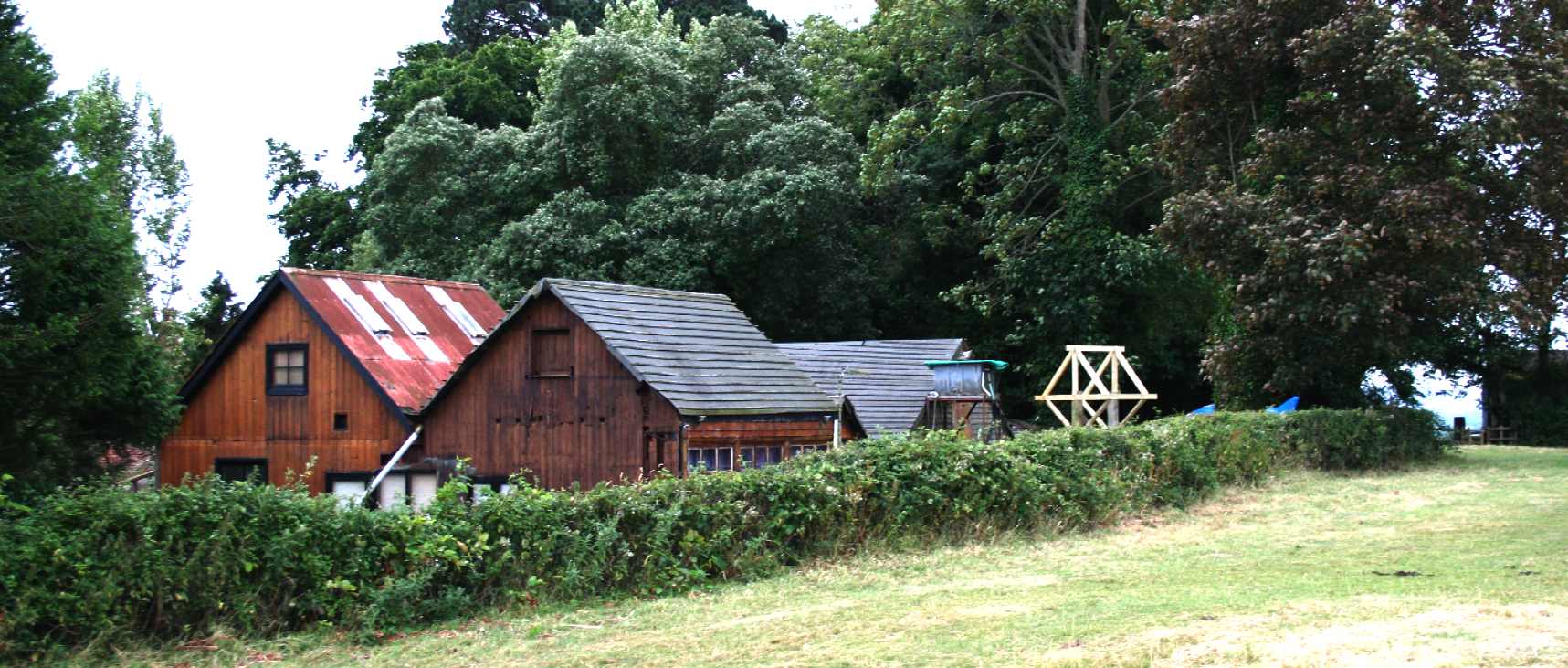
ELECTRIC
GENERATION IN THE COUNTRY - While many power houses were being built
by wealthy municipalities, typically powered by steam engines, not many
villages had their own supply. This is why Rudyard Kipling and Charles
de Roemer decided to cater for themselves, to enjoy the delight of
reliable lighting in their country homes when gas was so incredibly
dangerous as a light source and candles were easily extinguished
accidentally. Lime House was fitted with gas lighting. The remnants of
this source was removed in 1982, though the glass surrounds were
retained for electric fittings in the same positions as their gas
counterparts.

HERITAGE
INDEX A - Z
BARCLAYS
BANKING LET DOWN - MISSING ACCOUNT MONEY
BARON
CARL VON ROEMER
CAMPBELL
HALL - BLUEBIRD ELECTRIC CARS
GAS
ENGINES - COAL CONVERSION, INTERNAL COMBUSTION
HX
FIRE STATION
HX
MUSEUM
HX
SCIENCE EXHIBITS
OBSERVATORY
- HERSTMONCEUX CASTLE
SX
MUSEUMS
PLANNING
APP JAN 2015
RAF
BEACHY HEAD
RAF
HERSTMONCEUX
RAF
HERSTMONCEUX & WARTLING
RAF
SEAFORD BAY
SOLAR
LADY - STATUE
SUMMER
SOLSTICE
SUSSEX
TRUGGERY
THOMAS
ALVA EDISON
TOURISM
DCMS
TREE
HOUSES -
TREE
PRESERVATION
TRUGS
WORLD
ELECTRIFICATION HISTORY
WWII
AIR RAID SHELTER
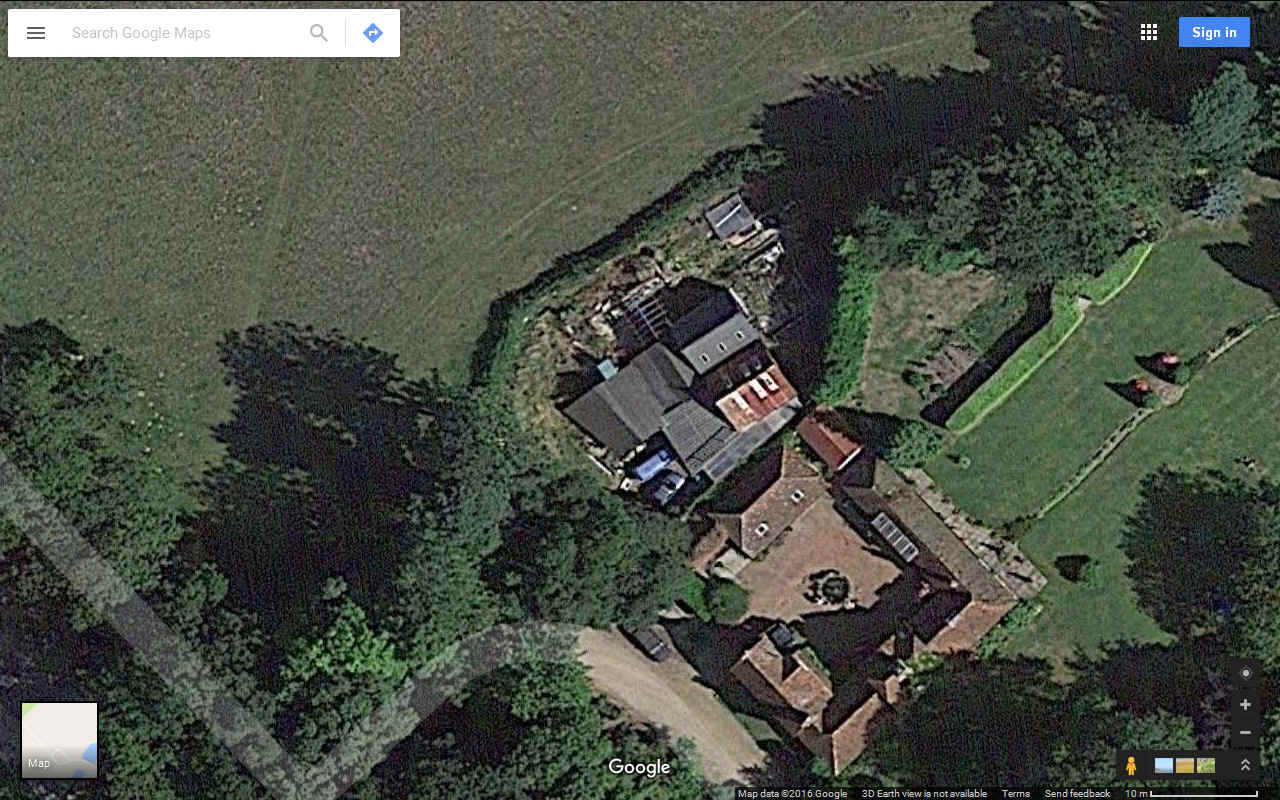
GOOGLE
MAPS
- The detail is not that great and the situation on the land is
significantly changed in that the site has undergone a massive clean up.
You cannot see the coal bunkers in this picture, but they are to the
rear of the main buildings.
|














